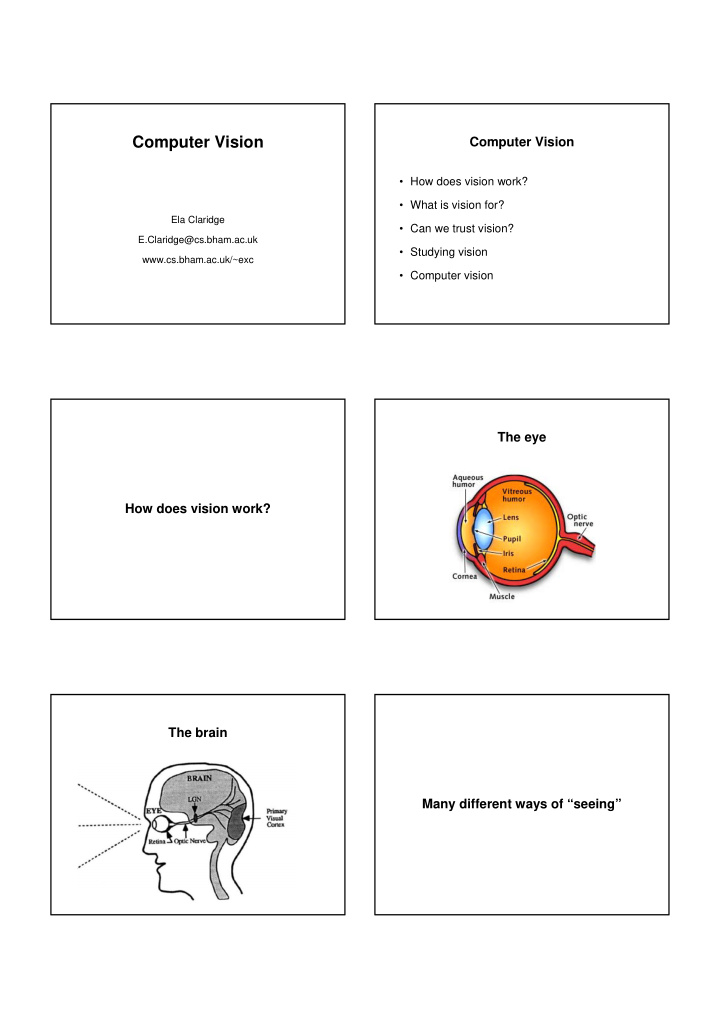



Computer Vision Computer Vision • How does vision work? • What is vision for? Ela Claridge • Can we trust vision? E.Claridge@cs.bham.ac.uk • Studying vision www.cs.bham.ac.uk/~exc • Computer vision The eye How does vision work? The brain Many different ways of “seeing”
Perception? How does vision work? • The eye sensor based on light What is vision for? • Making use of the sensed data interpretation internal representation
What is vision for? • for perceiving world of meaningful objects and events • for tracking the objects and events • for gaining accurate spatial information for moving about in the world and for manipulating it
... also ... • for communicating • for conveying ideas • for perceiving moods • for achieving aesthetic satisfaction • ............. Can we trust vision?
Can we trust vision? Senses may deceive us Can we trust vision? Can computer vision help? - Solutions Not all the knowledge comes from the image - Measure things - Develop image interpretation methods
Vision in action Vision as an intelligent process • To function in the world requires – means of sensing of the external world to respond to changing environment and internal needs Internal Sensor Interpretation – means of interpretation of the sensed signal (goal oriented) representation – internal representation of the world, to aid the interpretation and goal formation • Sensor, internal representation, interpretation and action are the generic components of any intelligent Action system, including an AI system • Vision has all the hallmarks of an intelligent process Fischler & Firschein (1987) “Intelligence: The Eye, the Brain and the Computer” Aaron Sloman Labyrinthine model of vision What is vision? Visual sub- Touch systems of various kinds “Vision is the extraction and analysis of information Taste from an optical image in preparation for, and Several Control databases execution of, behaviour within the scene.” Hearing Descriptions of many R.Watt (1991) “Understanding Vision”: AP different kinds Smell Etc ... Cognition Memory Studying vision • Neurophysiology (“wetware”) Studying vision • Neurophysiology (relationships between “wetware” and “software”) • Psychophysics / Cognitive Science(“software”) • Computer Science / Artificial Intelligence
Studying vision Studying vision Neurophysiology Neuropsychology • examines how visual processes are implemented in • tries to understand the visual impairments caused by the brain damage to specific areas of the brain • helps to find how a particular function may be • helps to identify functional units & interconnections implemented in the brain Studying vision Studying vision Psychophysics Cognitive Science & Computer vision • investigation how different visual stimuli affect performance • theories of vision may be explicitly formulated and • measuring the limits of the perception rigorously tested using computer models • helps to determine whether or not the algorithm is used by the visual system Image Studying vision processing Computer Science / Artificial Intelligence Digital • Image processing (sensing) image • Image analysis (interpretation) 204 163 163 163 204 204 234 234 234 204 204 204 204 204 163 163 163 204 204 234 234 234 234 234 234 234 • Computer vision (sensing / interpretation / action) 204 163 163 204 204 204 234 234 234 234 234 234 234 204 204 204 204 234 234 234 234 234 234 234 234 248 • Interdisciplinary work on vision modelling 204 204 204 204 234 234 234 204 204 163 163 204 204 234 234 234 234 234 234 234 204 163 134 134 134 163 234 204 163 134 134 119 112 102 98 94 94 98 102 – theories of vision may be explicitly formulated and rigorously 234 163 119 112 106 98 90 84 77 69 69 77 84 tested using computer models 163 112 102 94 87 80 69 77 60 54 54 60 65 134 102 90 80 65 60 54 39 31 31 31 39 47 112 94 80 65 54 47 39 31 31 31 31 39 47 106 87 65 54 39 31 31 31 31 31 31 39 47 94 77 60 39 21 21 31 31 31 31 31 31 39
Image processing Image processing • Image enhancement • Basic image representation in a computer 2D array of pixels: • Finding boundaries of image objects Image[X, Y] • Shape outlining • Labelling of image objects Image value corresponds to image brightness: Image[x,y]=0 (dark) • ... Image[x,y]=255 (bright) Arithmetic and logical operations on image pixels: New_image[x,y]=Image[x,y]-Image[x-1,y] Image interpretation • Object detection • Abnormality detection • Object tracking • Recognition
Object detection and tracking Abnormality detection Speech recognition Gait recognition / object tracking 2005 DARPA Grand Challenge After no vehicle could complete Computer vision the DARPA 2004 autonomous vehicle race, the agency ran the race again, with a $2 million prize up for grabs. Twenty • Navigation vehicles guided by GPS, lidar, radar, and cameras attempted • Autonomous terrain exploration the 132-mile desert course on October 8, 2005. Five made it to • Human – computer communication the finish line, proving the concept of a self-driving car. • Intelligent behaviour • Teamwork • . . . http://news-service.stanford.edu/news/2005/october12/stanleyfinish-100905.html
Kismet – an emotional robot Autonomous vehicle navigation (Mars, 2004) http://www.ai.mit.edu/projects/sociable/videos.html http://marsrovers.jpl.nasa.gov/gallery/video/animation.html Aibo Robot soccer communicating and learning robot Many flavours of computer vision • Empirical • Explanatory Many flavours of computer vision Finding out facts about Trying to explain underlying natural systems mechanisms
Many flavours of computer vision Many flavours of computer vision • Learning • Whole visual system • Parts or partial • Fixed abilities functions • Going beyond human • Modelling human Autonomous motion Detecting edges abilities abilities Understanding text Static images • Neural and symbolic • Algorithmic approaches approaches Further reading • Gregory LR (1997) “Eye and Brain”: OUP • Marr D (1982) “Vision”: Freeman • Fishler MA, Firschein O (1987) “Intelligence: the Eye, the Brain and the Computer”: Addison Wesley • Bruce V, Green PR, Georgeson MA (2003) “Visual Perception: Physiolgy, Psychology and Ecology”: PP • Sonka M, Hlavac V, Boyle R (1998) “Image Processing, Analysis and Machine Vision” Chapman & Hall http://homepages.inf.ed.ac.uk/rbf/CVonline/
Recommend
More recommend